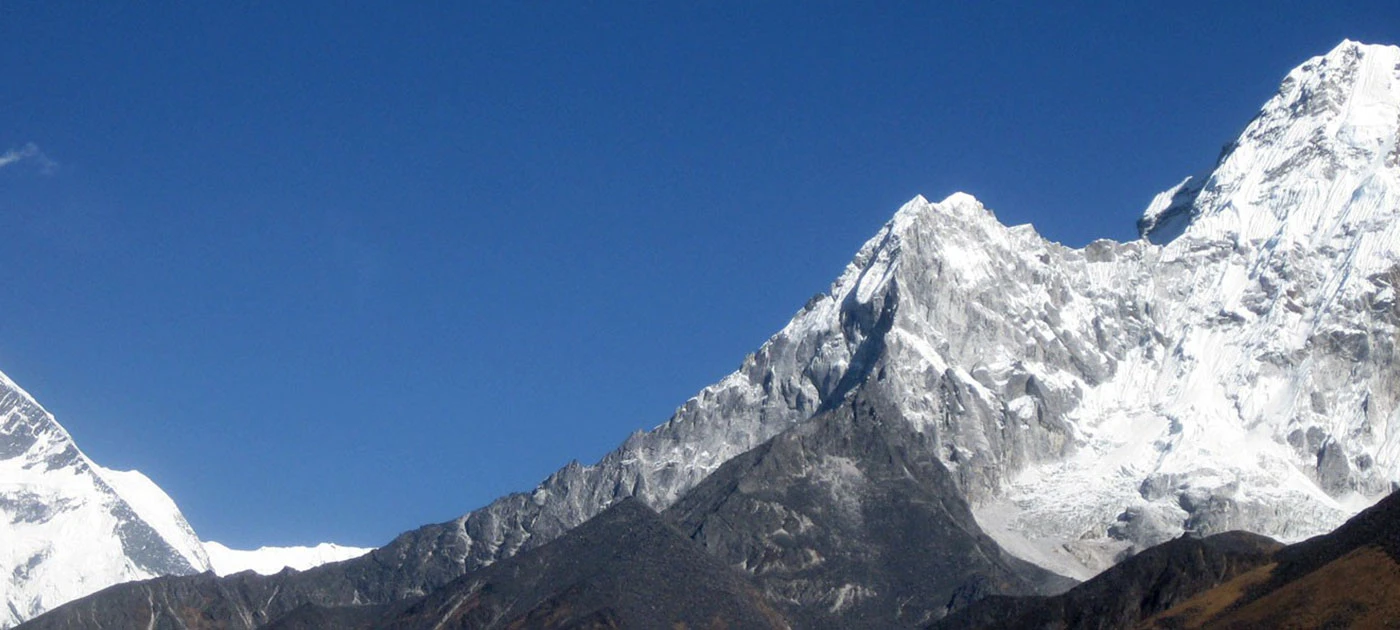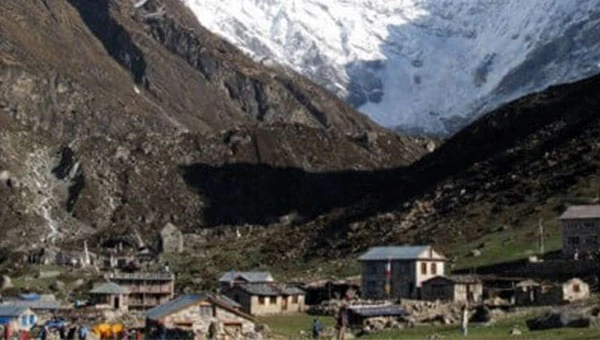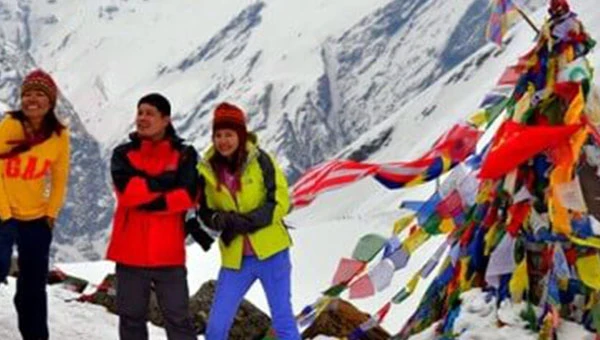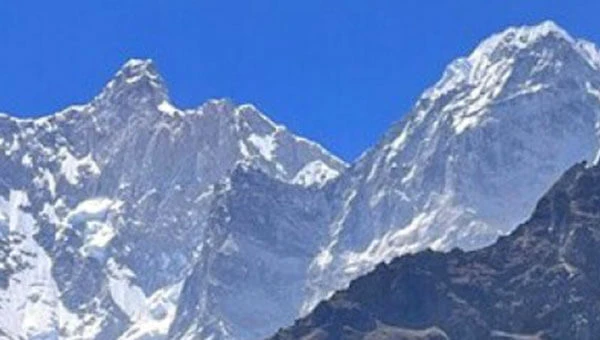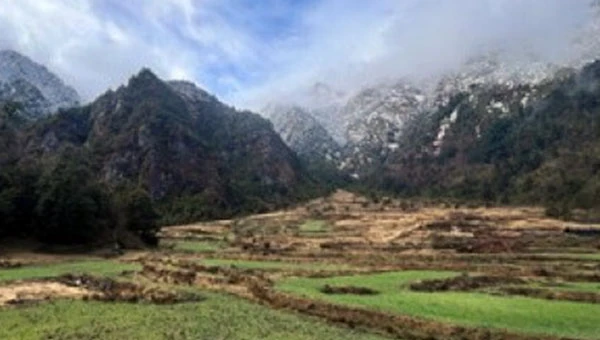Island Peak Climbing
Island Peak Climbing is known to be the first choice and the ideal peak for avid climbers. Island/Imjatse Peak Climbing, known as offering mesmerizing views of Mt. Everest from Kalapatthar and is graded as Peu Difficile (PD+) by the Swiss/French Alpine System. Topping that off, you will also get the opportunity to visit the various monasteries and experience the Buddhist religion and culture of the Sherpas firsthand. The Island Peak climbing itinerary, as suggested by Nepal Adventure Team, starts from a scenic flight from Kathmandu to Lukla and enters Namche Bazaar. Named after the Imjatse valley, the Island Peak climbing route passes through Everest Base Camp and then enters the Imjatse or Island. The trek then ends at Lukla.
Highlights
- Trek duration: 11-13 days
- Trek destination: Everest Base Camp, Kalapatthar, Imjatse/Island Peak Base Camp
- Trek Region: Everest/ Khumbu Region
- Beginning altitude: Lukla at 2820 m
- Highest Elevation: Island Peak at 6189 m
- Climbing Island Peak at 6189 m, and trekking to Everest Base Camp at 5364 m
- Panoramic views of Lingtren, Khumbutse, Changtse, Myt. Everest, Nuptse, Lhotse, Ama Dablam, and Thamserku
- Experience the life of Sherpas at Imja Khola valley, Khumjung village, and Namche village
- Trek up to Khumbu Glacier
Island Peak Climbing Cost
Since Island Peak falls in the Everest region and since the duration is long, the cost is generally greater than other expeditions. Many factors, like duration of the tour, transportation mode, climbing region, and requirements, largely determine the cost of Island Peak climbing. Considering all things, the total estimate of the Island peak climbing cost lands somewhere at $2031 per person. The cost includes basic things like Island Peak climbing permits, accommodation, and food.
Island Peak Difficulty
The Island Peak Climbing itinerary drafted by the Nepal Adventure team considers all the difficulties associated with the trip. Island peak difficulty is generally graded as PD+ (Peu Difficile), meaning technically difficult. One is generally required to be physically fit and must be able to endure the cold climate. From a mountaineering point of view, it is vital that in the course of climbing, you take all the precautions and be aware of the slightest symptom of AMS (Acute Mountain Sickness). You must be aware of symptoms such as dizziness, breathing problems, vomiting, headache, and treat them immediately with some medication.
Lobuche Peak Climbing
Lobuche Peak Climbing is one of the most exhilarating peak climbing expeditions in the Khumbu region at an elevation of 6189 m. The trek, although technically difficult, has been a popular peak climbing destination for avid climbers. From the views of Mt. Everest to the villages of Namche-Thyangboche-Pheriche, you can get a taste of both nature and the Buddhist religion. Lobuche Peak Itinerary, prepared by Nepal Adventure Team, is best suited for all your requirements. The trek starts from Lukla and then leads to Namche Bazaar. Eventually, it passes through Everest Base Camp towards Lobuche Base Camp and Lobuche High Camp. Then you will climb the Lobuche Peak and end the trek at Lukla.
Highlights
- Trek Duration: 11-13 days
- Trek Destination: Everest Base Camp, Lobuche High Camp, Lobuche Base Camp, Lobuche Peak
- Trek Region: Khumbu/Everest region
- Beginning Altitude: Lukla at 2820 m
- Highest Elevation: Lobuche Peak at 6119 m
- Panoramic views of Lobuche Peak, Lhotse, Ama Dablam, Pumori, Mt. Everest
- Views of a dozen Mountains from Kala Patthar
- Experience the culture of the Sherpa
- Pass the villages of Namche, Lobuche
- Visit monasteries and try the local cuisine
Lobuche Peak Climbing Cost
Lobuche Peak climbs in the Everest region are a relatively expensive peak climbing expedition due to the region it is situated in, and also due to the duration. To reach the Everest region, one has to travel to Lukla by air, which also adds to the cost. Lobuche Peak itinerary formed by NAT estimates the cost starting at US$2290 per person, which includes necessities like the Lobuche Peak permit, accommodation, and food. Factors like your requirements, travel cost, duration of the trip, and the destination also impact the cost of traveling.
Lobuche Peak Difficulty
Lobuche Peak difficulty is generally graded as TD+ (Tres Difficile), meaning very difficult by the International Swiss/French Alpine System. Since you will have to climb the Lobuche Peak, standing at 6119 m, and will also have to trek to Everest Base Camp as well as Lobuche High Camp, the entire tour is regarded as technically difficult. One is generally required to be physically fit and must be able to endure the cold climate. From a mountaineering point of view, it is vital that in the course of climbing, you take all the precautions and be aware of the slightest symptom of AMS (Acute Mountain Sickness). You need to take rest appropriately to acclimate your body and to avoid AMS. You must be aware of the symptoms of AMS and take medication.
Mera Peak Climbing
Mera Peak Climbing has acquired a lot of popularity over the years for its unique and traditional insight into the Himalayas and the Sherpa community, along with the green woodland in the Khumbu region. The Nepal Adventure team has formed one of the best Mera Peak itineraries for enthusiastic climbers to follow to have a safe and fun climb towards Mera Peak. The Mera Peak Climbing trip begins from Lukla and moves towards Tagnang. Eventually, the route takes you to Mera Base Camp and then High Camp. You will then climb Mera Peak Summit at 6461 m, and the trek will end at Lukla.
Highlights
- Trek Duration: 9 -11 days
- Trek Destination: Khare, Mera Base Camp, Mera Peak Summit
- Trek Region: Khumbu/Everest Region
- Beginning Altitude: Lukla at 2800 m
- Highest Elevation: Mera Peak Summit at 6461 m
- Panoramic views of Mera Peak, Mt. Everest,
- Walk through the hidden Hongu Drangkas, Hinku Valley, and enter the villages of the Khumbu area
- First-hand experience of the Buddhist religion and the cultures of the Sherpas
Mera Peak Climbing Cost
Since Mera Peak Summit is located in the Khumbu region so it is a relatively expensive expedition than others. Starting from US$2190 per person, the cost includes the Mera Peak Climbing permit, accommodation, and food. Mera Peak Climbing cost depends largely on your requirements, the duration of your travel, and the cost of travel. If you are a tourist living abroad, then you will also have to add the cost of flying to Nepal and residing here for the days of travel.
Mera Peak Difficulty
Mera Peak difficulty is graded as PD, meaning Peu Difficile, meaning it is less technically difficult by the Swiss/French Alpine System. Unlike other peak climbing, you will not have to put a high technical effort and skill into climbing. /it is regarded as a straightforward trekking peak, so one without much experience in peak climbing can also attempt to climb Mera Peak. Although not so difficult, it is essential to understand that you need to be physically fit to climb this peak. You must regularly exercise before the climb because you will have to trek 5-7 hours per day and will also have to climb the Mera Peak Summit at 6461 m. Since the altitude crosses over 3500 m so there are high chances that you may suffer from Altitude sickness. In case you spot any symptom of AMS, you must immediately go down or take medication as required. Thus, it is also beneficial to hire guides and porters for your convenience.
Things to consider before climbing the peaks:
Permits
Peak climbing in Nepal initiates a complete administrative process from the authority of Misery of Tourism and Civil Aviation and the Nepal Mountaineering Association(NMA). The peaks falling under the 5000 m to 7000 m range are classified as Trekking Peaks by NMA. The permit fees depend on the region that the peak falls in, the height of the peaks, and the number of members in your group. Thus, at your will, we can go through with the logistics and drive you towards the best climbing experience of your life.
Best time to climb the 3 peaks in the Everest Region
The best time for peak climbing in the Everest region is indeed the seasons of Spring and Autumn. In this season, the weather is generally clear with the best views. During this season, there will be fewer chances of heavy snow or heavy rainfall, so it is known to be the best season. The best time to go peak climbing in the Khumbu region is considered to be from February to mid-June and from September to November. February to mid-June is neither hot nor too cold. September to November marks spring, which is ideal for any kind of trek.
During the winter season, the trail might be full of heavy snow at higher altitudes. This might cause a problem since the trail might be lost and slippery. Also, you will have to pack a lot of warm clothes, which will add to your backpack. December and January are the winter seasons, which are marked by heavy snowfall in the higher altitudes, causing problems walking and climbing.
During the summer season, there might be chances of heavy rainfall, which might affect the flights. Your flights might be canceled at any time, and you will have to extend your trip. July and August are the times when there is heavy rainfall, causing the trail to be muddy and slippery, which ruins the trek.
So the best time to climb the above-mentioned peak is all around the year except July and August.
Guide and Porters
The top 3 peak climbing in the Everest region require guides and porters as far as possible. It is best advised that you take a guide and a few porters along with your group. The guides have full knowledge of the climbing experience on these peaks. The guides will show you easy routes and are best for negotiating with the locals. If you are a non-Nepali citizen, then it is best if you take a guide along with you since you will have to carry ropes and form knots on the trips; these technicalities can best be handled by the guides.
Porters, on the other hand, are equally very useful throughout the climb to these peaks. Our porters are similarly well known about the trek and climb, and are at all times fully equipped with gear. Since the trip lasts for more than two weeks, it is advised that you hire a porter who can carry most of your load. The porters are well looked after, and as per the company policy, a single porter will carry a maximum weight of 25 kg. A professional guide usually costs around $25 per day, which includes their fee, accommodation, food, and insurance.
Equipment
An important thing to note is that you should not bring any unnecessary equipment with you while you travel to Nepal. The necessary equipment can be hired here in Kathmandu. The following equipment and clothing are necessary for your trek. All of these can be purchased or hired from Kathmandu. The essential gear list for peak climbing in Nepal is given below:
Basic packing list:
- Travel documents and passport-size photos
- Boots and or trekking shoes
- Woolen/cotton socks (6-8 pairs)
- Gloves ( 2 pairs)
- T-shirts/ shirts (4-6 pcs)
- Trousers (2-3 sets)
- Shorts/tracksuit
- Fleece jacket and Down jacket
- Cap (for the day), Woolen hat (for evenings and mornings)
- Small and large towels
- Water bottle
- Sun/snow glasses
- Raincoat
- Walking poles
- First Aid kit
- Fleece sleeping bag liner
- Torch/flashlights
- Penknife/ Swiss Army knife
- Scarf/mask
- Duffle bags (carried by porters or animals)
- Rucksack/ backpack
- Personal hygiene products and toiletries ( female hygiene products are not found easily on the trails)
- Sleeping bag with inner liner
- Wide-brimmed hat (great for protecting your head, face from the sun)
- Two large waterproof rucksack covers
- Water purification tablets and refillable bottles
Climbing gear:
- Ice ax
- Crampons
- Harness
- Tape slings
- Helmet
- Plastic mountaineering boots
- Ascender
- Descender/eight-figure
- Screwgate Karabiners
Group Climbing Gears:
- Snow bar
- Rope
- Ice hammer
- Ice screw
Note: Consult with our team to hire the gear in Nepal
Safety and Security
The top 3 peak climbing regions mentioned above a secured areas for tourists and avid climbers. Our agency makes sure that all the climbers are given the utmost safety during their stay in Nepal. Our team members, including the guides and porters, will help you in any case of uncertainty, whether it is natural disasters or political instability. Thus, it is best advised that you prepare yourself with all the necessary equipment and hire a guide and porter if possible. Most of the locals residing in the Everest/Khumbu region are very friendly and helpful. It is also advised that you travel by a taxi or a tourist bus since they are safer alternatives to traveling in Nepal. This also helps if you cannot stand traffic jams and chaotic and overcrowded vehicles. It is suggested that you avoid political rallies and that you keep a day or two in case of inconvenience. However, it is safe to say that our agency will keep your safety and security in mind. Also, you must follow all the rules that have been set by the tourism board and that our travel agency suggests, then you are good to go.
Island Peak climbing, Mera Peak Climbing, and Lobuche Peak Climbing are among the best peak climbing expeditions in Nepal. These peaks in Nepal offer mesmerizing views of the Everest Region under a clear sky. Panoramic views of Mt. Everest, Nuptse, Lhotse, Ama Dablam, and Thamserku are perhaps the highlight of peak climbing in the Everest region. The stunning valleys and villages on the route to these peaks and the unique flora and fauna are what make these trips special.
Join the Nepal Adventure team Pvt. Ltd for the best peak climbing experience in the Everest region. We provide safe and fully guided services so that your experience with us is one of a kind, with all the enjoyment and adventure. Although Island Peak climbing, Mera Peak Climbing, and Lobuche Peak Climbing are the best and most demanded peak climbing in Nepal, we also offer other peak climbing packages in Nepal. Last-minute bookings are also available for peak climbing in Nepal.
For further inquiry, please contact us through our live chat, email, or telephone.
